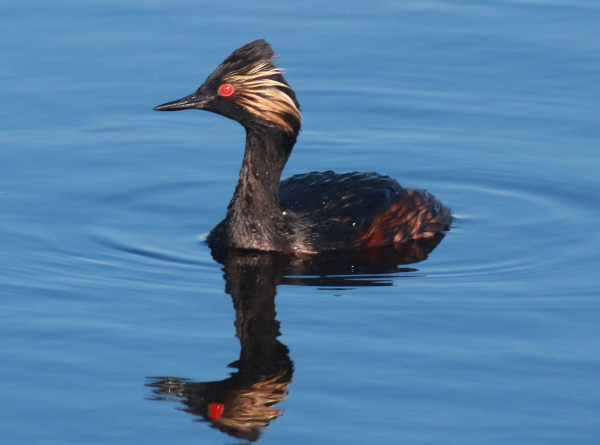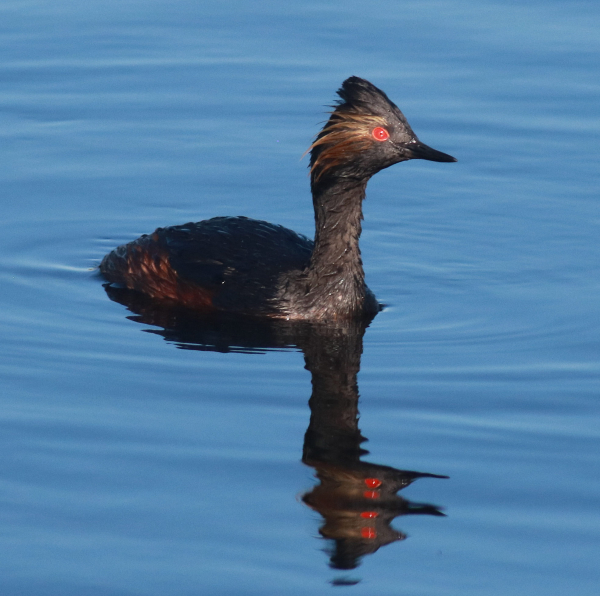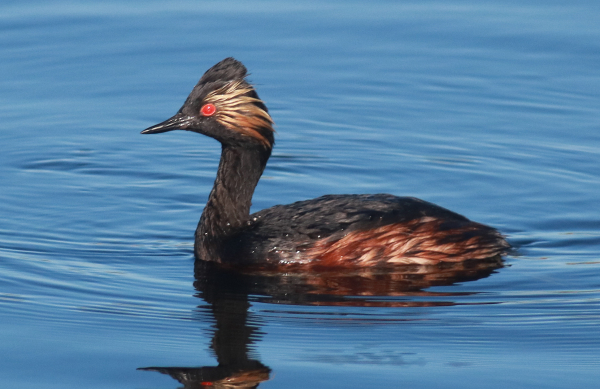
Timing, perfect sunlight, and calm water reflecting blue sky provided a simple photo opportunity and a series of 13 photos of an interesting bird. This Eared Grebe photo is also the product of editing – selecting the best two photos in the series, and doing some simple cropping to improve the image.
|
Let’s make things simple this week. No long lists of how-to information or a variety of photo applications. Let’s hold it down to one bird, in good light, on calm water, close. Simple; take a photo or two – right? Well, that’s the norm; but what’s your hurry? In this digital photo age, stick with this interesting subject as long as possible and take a series of photos that you can choose a few keepers from. The bird turns right (click), then left (click), turns broadside (click, click), and when it swims toward you (click, click, click). Then it dives into the water, and emerges in the cattails – photo session over. Nonetheless, that bird just provided you with a great opportunity to take a series of photos while sharing some moments with it one on one – Great! Experiences like that are what we all wish for.
Last Thursday, I had just that kind of experience when I stopped at an opening in an expansive area of cattails south of McKenzie, North Dakota. I was attracted to the open water by an American Coot feeding three downy hatchlings, two drake Blue-winged Teal, a displaying male Ruddy Duck, and two Eared Grebes. Moments after I stopped, the coot approached the grebes aggressively, making them dive underwater. One grebe surfaced a distance away, but the other popped up right in front of me; I couldn’t have positioned it better if I had placed it there myself. I took a series of 13 photos; then it dived again and resurfaced in the cover of cattails.
Editing – The photo session was over, but now I had a nice series of photographs taken under great field conditions recorded on my camera’s photo card. Next step: View and edit the photos in my laptop computer. Using my series of 13 photos as an example, after reviewing each one, you have a good idea of which image or images stand out. Take a second look, and narrow it down to the true keepers – one or two that are best in every way.
The grebe wasn’t very active, which made photo editing pretty simple. As I reviewed the photos, it became quickly obvious that although there was perfect light, as the bird turned its head, the color and brightness of the “ear” feathers that stream behind the bird’s eyes changed with the slightest move to the left and right. Similarly, the neck and body feathers were illuminated best when the ear feathers were brightest. This is best illustrated by the three photos provided in this article. The second photo shows the grebe in relatively poor lighting compared to the other two, simply due to a turn of its head.

This photo was not one of the two best photos selected from the series, but it illustrates how the slight turn of the grebe’s head can make a big difference in whether the light does or doesn’t fully illuminate the “eared” feathers and the rest of the bird. This image also illustrates the importance of cropping a photo, especially in the case of the reflection, which is rather distracting with its four-eyed reflection.
|
Cropping – The best two photos only needed to have the extra area of blue water cropped away. I left a pleasing area of water surrounding the Eared Grebe in each photo – a calm uncluttered beautifully colored background and foreground of blue.
An important aspect of cropping – eliminating extraneous background areas of a photo – is that you are effectively enlarging the relative size of the Eared Grebe.
A second element in these photos is the reflection of the grebe in the mirror-like water. The reflection is important enough to the image that you want to make sure it doesn’t detract or degrade the photo. For instance, in the non-keeper second photo used to illustrate this article, the reflection is distracting, especially the four-some of reflected eyes. By contrast, the first photo’s reflection was cropped so the grebe reflection adds to the image, instead of detracting from it.

While action photos are more dramatic, it’s always good to have a standard portrait image or two of each species. Simply photograph, edit, and crop.
|
In this case, it’s easy to keep things simple, which is not always the case. But using this simple example, when you have a larger series of photos with plenty of action involved, you can use this as a basis to begin with and expand upon. Enjoy the process – photographing, editing, and cropping – each is fulfilling, as is sharing your work with others. Good luck as we approach the beginning of summer; such a great time of the year for birders who enjoy bird photography.
Article and photos by Paul Konrad
Share your bird photographs and birding experiences at editorstbw2@gmail.com